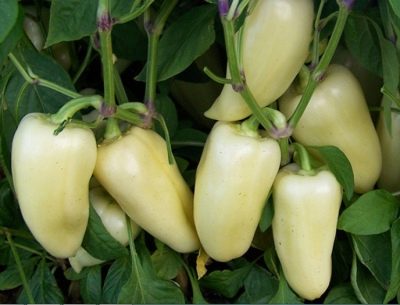
- Authors: Holland
- Name synonyms: Khaski
- Year of approval: 2015
- Bush height, cm: up to 80
- Growth type: undersized
- Fruit shape: proboscis
- Fruit weight, g: 80-100
- Fruit color: greenish-white in technical ripeness, red in biological ripeness
- Ripening terms: early
- Ripening month: July August
For regions with short summers, early maturing varieties of pepper are suitable, which manage to bring the harvest before the cold weather. Bell peppers F1 Husky are distinguished by accelerated ripening of fruits, as well as impressive endurance, because it is no coincidence that it is named after one of the fastest sled dogs used by humans in the Far North.
Breeding history
Pepper Husky F1 (Khaski) is a Dutch hybrid variety derived from the world-renowned seed company Enza Zaden. Since 2015, the culture has been included in Rosreestr and approved for cultivation in many regions of the Russian Federation.
Description of the variety
Husky pepper is a hybrid of bell pepper. High productivity, as well as resistance to the harsh climate, made this variety of pepper popular among vegetable growers, especially in regions of risky farming. This hybrid is not afraid of temperature extremes, rain, drought or heat. All of these situations will not affect productivity. Husky fruits are perfectly transported and stored.
Characteristics of the appearance of plants and fruits
The plant is medium- or short-growing, the height can reach 80 cm. It is a semi-sprawling shrub with drooping fruits. The peppers are all homogeneous, very beautiful, from an ivory shade at the moments of technical ripeness to a deep red at the stage of fully ripe fruits. Peppers have a classic conical or proboscis shape.
Fruit sizes: diameter 6 cm, length 11 cm. Average weight - 80-100 grams. The walls are 6-8 mm thick.
Purpose and taste
Husky are versatile peppers. They can be used both for fresh consumption and for various processing, conservation, freezing. The structure of the vegetable is dense and fleshy.
Ripening terms
The ripening of beautiful fruits occurs in 90-115 days from germination to fruiting.
Yield
The yield in open beds in the southern regions is 4.8 kg of marketable fruits per sq. m.

To get a large and tasty harvest of pepper, you need to take care of the seedlings in advance. When growing pepper seedlings, you need to correctly determine the sowing time, pre-sowing seed treatment, prepare the necessary container and soil.
Growing and care
In order for the seeds of the Husky hybrid to take root well in open ground or in protected ground, you need to perform simple care measures. At the time of planting, the land must be fertilized and moistened. The norm of daylight hours when growing seedlings in a greenhouse structure should be at least eight hours.
Regular drip irrigation will help the plant grow well. Irrigation is carried out only after the upper earthen layer has completely dried. After the appearance of the 2nd leaf, the seedlings are fed every 2 weeks with mineral complexes.
40-50 days after sowing, the grown seedlings are planted on a permanent bed according to the scheme 40 × 80 cm.Recommended placement - no more than four bushes in an area of one square meter. It is necessary to feed the hybrid variety about 2 or 3 times during the growing season with mineral fertilizers, including the potassium content.

To harvest a tasty and rich harvest of pepper, you need to comply with all the conditions of agricultural technology, and proper care begins with planting plants. Before planting pepper in open ground, it should be prepared. It is also important to take care of the seedlings and planting space in advance.




For good growth of pepper bushes and active fruiting, you need to regularly apply mineral and organic fertilizing to the soil. It is necessary not only to choose the right formulations, but also to use them at the right stage in the development of culture. The frequency of top dressing is always individual. It depends directly on the composition of the land on your site. The poorer the soil composition, the more often you will need to feed the pepper.
Disease and pest resistance
The hybrid variety Husky demonstrates resistance to diseases such as black bacterial spot and TMV (Tobacco Mosaic Virus). However, the crop is vulnerable to insect pests.
Spraying the affected fragments with folk compounds, such as a decoction of tansy or wormwood, as well as an infusion of yarrow, helps against aphids and ticks. Spraying with celandine infusion will help to fight the Colorado potato beetle. The appearance of slugs on the garden bed can be avoided by planting parsley next to the pepper.
A particularly harmful insect is the whitefly butterfly. If you manage to find it in time, then you can simply wash it off with a large amount of settled water. In the case when the plant is severely affected, it should be treated with Inta-Vir.

Pepper is one of the most common vegetables in home gardens. This culture is quite stable and unpretentious. However, under certain conditions, this plant can suffer from infections and harmful insects. Before treating peppers for diseases or pests, you need to find out the cause of the problem, otherwise the treatment may be ineffective.





















































































